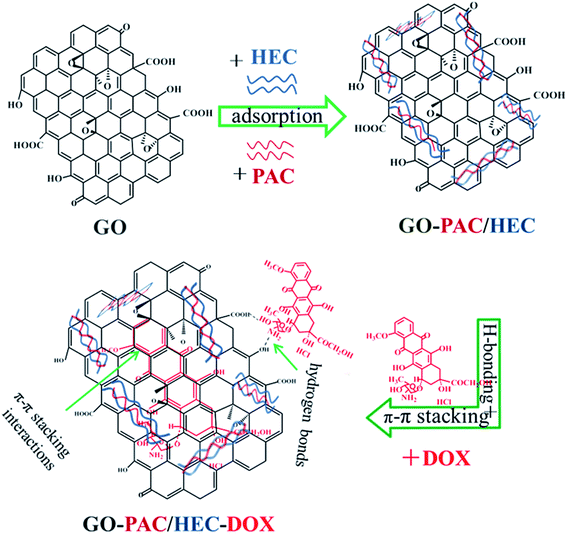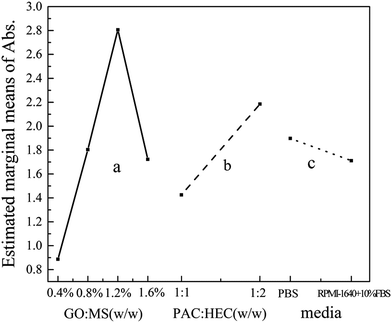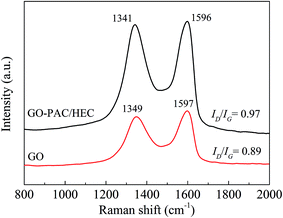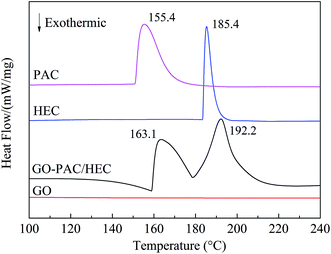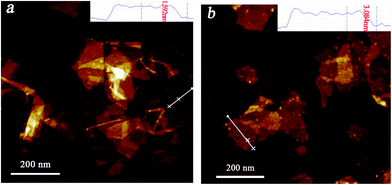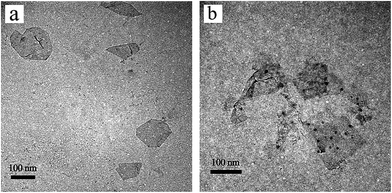Mixed surfactant modified graphene oxide nanocarriers for DOX delivery to cisplatin-resistant human ovarian carcinoma cells
Qian Zhanga,
Huirong Chia,
Mingzhi Tanga,
Jiabin Chena,
Guolin Li*a,
Yushi Liu*b and
Bing Liu*ac
aDepartment of Oral and Maxillofacial Surgery, The First Affiliated Hospital of Harbin Medical University, 23 Youzheng Street, Nangang District, Harbin 150001, People's Republic of China. E-mail: liguolin@126.com
bSchool of Civil Engineering, Harbin Institute of Technology, Heilongjiang, Harbin, 150090, China. E-mail: liu15124558349@163.com
cTranslational Medicine Research and Cooperation Center of Northern China, Heilongjiang Academy of Medical Sciences, China
First published on 7th September 2016
Abstract
The non-covalent functionalization of graphene oxide (GO) with hydroxyethyl cellulose (HEC, nonionic surfactant) and polyanionic cellulose (PAC, anionic surfactant) was developed for anti-cancer drug delivery applications based on a nonideal mixed micelle theory of surfactants. In order to maintain the stability of GO in aqueous electrolytes, the optimal component of the mixed surfactant modified nanocarriers (GO–PAC/HEC) was determined via a multi-factors orthogonal method. Benefiting from the enormous specific surface area of GO and π–π stacking interactions, doxorubicin hydrochloride (DOX), a model anticancer drug, was loaded onto the GO–PAC/HEC surface with high drug loading. The most appropriate loading content of DOX on GO–PAC/HEC was obtained by zeta potential evaluation and a stability time test. The in vitro DOX release profiles from DOX-loaded nanocarriers (GO–PAC/HEC–DOX) exhibited a significant pH-responsive feature and satisfactory performance of drug controlled release. Moreover, in vitro investigation showed that DOX-loaded nanoparticles entered into and treated cancer cells effectively and enhanced the accumulation of DOX in SKOV3/DDP cells (cisplatin-resistant human ovarian carcinoma cell line) exhibiting higher cytotoxicity than free DOX, suggesting that DOX-loaded nanoparticles may overcome DOX resistance of SKOV3/DDP cells to some extent. Based on the results obtained in this study, GO–PAC/HEC shows considerable potential as a drug delivery vehicle.
1. Introduction
Nanotechnology and nanomaterials have inspired many new research fields over the past decade.1,2 Their applications span many subject areas and they possess further huge potential, including in the medical domain.3–8 Nanoscale drug carriers, combining nanotechnology with advanced drug delivery, are divided into two types: organic materials such as lipids9 and polymers,10 and inorganic materials such as noble metals,11 oxides12 and, carbon-based nanomaterials13 etc.Nanographene oxide (NGO), a two-dimensional carbon nanomaterial, has aroused considerable attention in the biomedical community in recent years. As an oxidized form of graphene, graphene oxide (GO) has many epoxy, hydroxyl and carboxyl groups on the surface and can be easily dispersed in aqueous solution.14,15 Another significant advantage offered by GO is that it possesses a high aromatic drug loading efficiency (DLE) because of its enormous specific surface area and extended π–π conjugated system.16–19 Qin et al. reported that the loading content of doxorubicin hydrochloride (DOX) on FA–NGO–PVP (folic acid–grafted graphene oxide with polyvinylpyrrolidone) could reach 107.5%, much more efficient than conventional drug carriers.20 Moreover, Wu et al. reported that GO used as a carrier for Adriamycin (ADR–GO) could overcome drug-resistance in breast cancer cells.21 In addition, GO shows certain marked advantages in terms of particle size control, controlled release, and optical properties etc.22,23
Although GO possesses many good properties including good dispersion in deionized water, flocculation under physiological conditions is problematic. Consequently, surface modification is necessary to guarantee the stability and compatibility of GO with biological systems. The possible approaches to surface modification are through covalent24,25 and non-covalent.26 Non-covalent modification has attracted growing interest because of its universality and simplicity. The non-covalent modification of GO with biocompatible surfactants such as PEG,27 polyvinylpyrrolidone (PVP)20 and Tween28 have been reported and have achieved stability improvements. However, along with the instability of surfactants themselves in salt solutions containing electrolytes, the colloidal stability of GO continues to be a problem. Fortunately, nonideal mixed micelle theory of surfactants provides a new perspective for surface modification of GO.29 The nonideal mixed micelle theory includes the synergistic characteristics of mixed surfactants that can act to improve their overall stability in electrolyte solutions.30,31 For example, in an anionic–nonionic surfactant system, the nonionic surfactant introduced can bind metallic cations and restrict their mobility in electrolyte solutions. Hence the interactions between cations and negatively charged groups of the anionic surfactant may be weakened, improving the salt-resistance of anionic–nonionic surfactants systems.32
Although the nonideal mixed micelle theory of surfactants has been reported previously, it has not been applied in the form of mixed surfactants modified GO nanocarriers for anti-cancer drug delivery. In this study, hydroxyethyl cellulose (HEC) and polyanionic cellulose (PAC) were chosen as the nonionic–anionic synergistic surfactants32,33 to prepare GO nanocarriers stable in the presence of aqueous electrolytes. The optimal composition of the mixed surfactant was investigated by the multifactorial orthogonal method. DOX, a model chemotherapeutic agent was used to examine the loading and controlled release behavior of the nanocarriers (GO–PAC/HEC). The optimum proportion of DOX to GO–PAC/HEC was further confirmed by zeta potential measurements and stability time tests. In addition, the effects of the DOX-loaded nanoparticles on the human ovarian carcinoma cell line SKOV3 and cisplatin-resistant human ovarian carcinoma cell line SKOV3/DDP were investigated by cell viability assay and cell internalization studies.
2. Experimental section
2.1 Materials
Human ovarian carcinoma cell line SKOV3 and cisplatin-resistant human ovarian carcinoma cell line SKOV3/DDP were purchased from Peking Yin Zijing Biological Medicine Technology Co. Ltd. Natural flake graphite, was purchased from Jinrilai Electronic Materials Factory (Qingdao, China). Hydroxyethyl cellulose (HEC) with a molecular weight of 300![[thin space (1/6-em)]](https://www.rsc.org/images/entities/char_2009.gif) 000 g mol−1 was purchased from Aladdin Industrial Co. (China). Polyanionic cellulose (PAC, medium viscosity, degree of substitution ≥0.9) was purchased from Hubei Xinyuanshun Pharmaceutical Chemical Co., Ltd (China). Cisplatin (cis-DDP), doxorubicin hydrochloride (DOX) and thiazolyl blue tetrazolium bromide (MTT) were obtained from Sigma-Aldrich (St Louis, MO, USA). Dialysis bags (MWCO = 2000 Da) were purchased from Shanghai Lvniao Technology Corp. All other reagents of analytical grade were used as received unless otherwise stated.
000 g mol−1 was purchased from Aladdin Industrial Co. (China). Polyanionic cellulose (PAC, medium viscosity, degree of substitution ≥0.9) was purchased from Hubei Xinyuanshun Pharmaceutical Chemical Co., Ltd (China). Cisplatin (cis-DDP), doxorubicin hydrochloride (DOX) and thiazolyl blue tetrazolium bromide (MTT) were obtained from Sigma-Aldrich (St Louis, MO, USA). Dialysis bags (MWCO = 2000 Da) were purchased from Shanghai Lvniao Technology Corp. All other reagents of analytical grade were used as received unless otherwise stated.
2.2 Apparatus
Fourier transform infrared (FT-IR) spectra (KBr pellets) were recorded on a Spectrum One instrument (PerkinElmer, USA). The zeta potentials of the samples were measured on a Zetasizer Nano-Z (Malvern, England). The micromorphology and size of GO–PAC/HEC and GO–PAC/HEC–DOX were examined using a JEM-2100 transmission electron microscopy (TEM, JEOL, Japan) and Dimension Icon atomic force microscope (AFM, Bruker Co., Germany). Ultraviolet-visible (UV-vis) spectra were measured on a SHIMADZU UV-2550 UV-vis spectrophotometer. The differential scanning calorimetry (DSC) analyses of the compounds were performed using a differential scanning calorimetry (DSC, NETZSCH, 200F3). The scanning temperature range is from 100 °C to 240 °C. The scanning rate was 10 °C min−1. Raman spectra were recorded with a Renishaw inVia Raman microscope (Renishaw Corporation, Britain) by an argon-ion laser at an excitation wavelength of 532 nm.2.3 Preparation of the GO–PAC/HEC nanocarrier
In order to obtain stable GO nanocarriers that did not flocculate in electrolyte solutions, the amount of hydroxyethyl cellulose (HEC) and polyanionic cellulose (PAC) were investigated in media of different electrolytes. Orthogonal tests designed through Statistical Product and Service Solutions software (SPSS) were carried out. The experiment was organized as an L8 (41 × 24) orthogonal array, as listed in Table 1.| Factors | Levels | |||
|---|---|---|---|---|
| 1 | 2 | 3 | 4 | |
| a Note: MS: mixed surfactants. PBS: phosphate buffered solution RPMI-1640 + 10% FBS: RPMI-1640 culture medium containing 10% fetal bovine serum. | ||||
GO![[thin space (1/6-em)]](https://www.rsc.org/images/entities/char_2009.gif) : :![[thin space (1/6-em)]](https://www.rsc.org/images/entities/char_2009.gif) MS (w/w) MS (w/w) |
1![[thin space (1/6-em)]](https://www.rsc.org/images/entities/char_2009.gif) : :![[thin space (1/6-em)]](https://www.rsc.org/images/entities/char_2009.gif) 0.4 0.4 |
1![[thin space (1/6-em)]](https://www.rsc.org/images/entities/char_2009.gif) : :![[thin space (1/6-em)]](https://www.rsc.org/images/entities/char_2009.gif) 0.8 0.8 |
1![[thin space (1/6-em)]](https://www.rsc.org/images/entities/char_2009.gif) : :![[thin space (1/6-em)]](https://www.rsc.org/images/entities/char_2009.gif) 1.2 1.2 |
1![[thin space (1/6-em)]](https://www.rsc.org/images/entities/char_2009.gif) : :![[thin space (1/6-em)]](https://www.rsc.org/images/entities/char_2009.gif) 1.6 1.6 |
PAC![[thin space (1/6-em)]](https://www.rsc.org/images/entities/char_2009.gif) : :![[thin space (1/6-em)]](https://www.rsc.org/images/entities/char_2009.gif) HEC (w/w) HEC (w/w) |
1![[thin space (1/6-em)]](https://www.rsc.org/images/entities/char_2009.gif) : :![[thin space (1/6-em)]](https://www.rsc.org/images/entities/char_2009.gif) 1 1 |
1![[thin space (1/6-em)]](https://www.rsc.org/images/entities/char_2009.gif) : :![[thin space (1/6-em)]](https://www.rsc.org/images/entities/char_2009.gif) 2 2 |
||
| Media | PBS | RPMI-1640 + 10% FBS (cell culture medium) | ||
Sample preparation was as follows: firstly, we synthesized GO nanosheets by a modified Hummer method19 using natural flake graphite. Nano-sized GO was prepared by sonicating GO nanosheets dispersed in deionized water (400 W) for 2 h. Subsequently, the dried nano-sized GO were obtained by lyophilization. PAC and HEC in the various ratios were dissolved in each of the two media. These solutions were magnetically stirred (1500 rpm) at room temperature for 30 min. GO nanoparticles were then added to each solution, gradually, and stirred for another 2 h. Then, all the samples were ultrasonicated for 10 min at 120 W and centrifuged at 3000 rpm for 5 min.34 The stability of the suspensions was evaluated using UV-vis spectrophotometry at 230 nm by measuring the optical density of the supernatants.35
To further purify GO nanocarriers determined by orthogonal method, the GO–PAC/HEC solid was separated from suspension through centrifugation at 10![[thin space (1/6-em)]](https://www.rsc.org/images/entities/char_2009.gif) 000 rpm for 30 min, followed by washing with deionized water three times.36 After that, the sample of GO–PAC/HEC nanocarriers was obtained by lyophilization.
000 rpm for 30 min, followed by washing with deionized water three times.36 After that, the sample of GO–PAC/HEC nanocarriers was obtained by lyophilization.
2.4 Preparation of DOX-loaded GO–PAC/HEC nanoparticles
DOX-loaded GO–PAC/HEC nanoparticles were prepared by simple mixing. DOX was gradually added to 5 mL of GO–PAC/HEC nanocarrier suspended in PBS according to the different mass ratio of DOX to GO (0.5![[thin space (1/6-em)]](https://www.rsc.org/images/entities/char_2009.gif) :
:![[thin space (1/6-em)]](https://www.rsc.org/images/entities/char_2009.gif) 1; 1
1; 1![[thin space (1/6-em)]](https://www.rsc.org/images/entities/char_2009.gif) :
:![[thin space (1/6-em)]](https://www.rsc.org/images/entities/char_2009.gif) 1; 2
1; 2![[thin space (1/6-em)]](https://www.rsc.org/images/entities/char_2009.gif) :
:![[thin space (1/6-em)]](https://www.rsc.org/images/entities/char_2009.gif) 1; 3
1; 3![[thin space (1/6-em)]](https://www.rsc.org/images/entities/char_2009.gif) :
:![[thin space (1/6-em)]](https://www.rsc.org/images/entities/char_2009.gif) 1; 4
1; 4![[thin space (1/6-em)]](https://www.rsc.org/images/entities/char_2009.gif) :
:![[thin space (1/6-em)]](https://www.rsc.org/images/entities/char_2009.gif) 1). After vigorous stirring overnight at room temperature in the dark, the mixture was separated by centrifugation at 13
1). After vigorous stirring overnight at room temperature in the dark, the mixture was separated by centrifugation at 13![[thin space (1/6-em)]](https://www.rsc.org/images/entities/char_2009.gif) 000 rpm and washed three times with PBS solution to remove unloaded DOX molecules. The amount of DOX in the supernatant was measured by UV-vis spectrophotometry at 480 nm against a calibration line generated from a series of DOX solutions of different concentrations using linear regression.
000 rpm and washed three times with PBS solution to remove unloaded DOX molecules. The amount of DOX in the supernatant was measured by UV-vis spectrophotometry at 480 nm against a calibration line generated from a series of DOX solutions of different concentrations using linear regression.
Drug loading content (DLC) and drug loading efficiency (DLE) were calculated according to the following formulae:
| DLC (%) = (Mi DOX − Ms DOX)/MGO × 100% |
| DLE (%) = (Mi DOX − Ms DOX)/Mi Dox × 100% |
2.5 In vitro drug release assay
The release of DOX was studied in round-bottomed flasks containing either phosphate buffer (100 mL, PBS, pH = 7.4) or acetate buffer (100 mL, pH = 5.0) solutions, respectively. DOX-loaded nanoparticles (4 mL, containing 1.5 mg of DOX) were placed in a dialysis bag (MWCO = 2.0 kDa) which was immersed in the release medium, and the flasks placed in a shaker at a constant temperature (37 °C). At a series of time intervals, a 3 mL sample was withdrawn and replaced with an equal volume of fresh buffer. The amount of DOX released from GO–PAC/HEC into the receptor media was quantified using the fluorescence measurements at an excitation wavelength of 470 nm. The drug-release determinations were performed in triplicate, and the average values are reported.2.6 Cell culture
Both human ovarian carcinoma cell line SKOV3 and cisplatin-resistant human ovarian carcinoma cell line SKOV3/DDP were cultured in RPMI-1640 containing 10% fetal bovine serum at 37 °C in a humidified atmosphere containing 5% CO2. SKOV3/DDP cells were routinely cultured with 0.5 μg mL−1 cis-DDP to maintain drug resistance, but the cells were transferred to drug-free RPMI-1640 medium one month before experiments.2.7 In vitro cytotoxicity of GO–PAC/HEC nanocarriers
The relative cytotoxicity of GO and GO–PAC/HEC nanocarriers was estimated by MTT viability assay. In the MTT assay, SKOV3 cells were seeded into 96-well plates at a seeding density of 5.0 × 103 cells per well in 200 μL of RPMI-1640 for 24 h. The culture medium was then removed and replaced with 200 μL of fresh medium containing different concentrations of GO or GO–PAC/HEC nanocarriers for 48 h. At the end of this period, 20 μL of 5 mg mL−1 MTT solution was added to each well and the cells incubated for a further 4 h at 37 °C. Finally, the MTT solution was replaced by 200 μL DMSO with agitation for 10 min and the absorbance measured by automatic microplate reader at a wavelength of 490 nm.2.8 In vitro cytotoxicity of DOX-loaded nanoparticles and cis-DDP
Inhibition of SKOV3 and SKOV3/DDP cell proliferation by DOX-loaded nanoparticles was measured by the MTT assay. The MTT assay was also used to confirm the level of resistance of this cell line to cis-DDP. The cells were cultured in 96-well plates at a density of 5 × 103 cells per well in 200 μL of RPMI 1640 for 24 h at 37 °C. The medium was then removed and replaced by fresh medium containing different concentrations of cis-DDP, DOX-loaded nanoparticles or free DOX and the cells incubated for 48 h at 37 °C. At the end of this period, 20 μL of 5 mg mL−1 MTT solution added to each well and the cells incubated for a further 4 h. Finally, the medium containing unreacted MTT was removed and replaced by 200 μL DMSO and incubated for 10 min with agitation. Absorbance was measured by automatic microplate reader at a wavelength of 490 nm.2.9 Intracellular localization of DOX-loaded nanoparticles
Fluorescence microscopy was used to visualize the intracellular localization of DOX-loaded nanoparticles in SKOV3 and SKOV3/DDP cells with free DOX treated cells used as the control. The cells were seeded into glass bottom culture dishes at a density of 1 × 104 cells per dish in 2 mL of culture medium and incubated overnight. The culture medium was removed and replaced with 1 mL of RPMI-1640 medium (without FBS) containing DOX-loaded nanoparticles or free DOX at a final DOX concentration of 10 μg mL−1. The cells were incubated at 37 °C for predetermined intervals. The culture medium was then removed, and the cells were washed with PBS to remove free nanoparticles. The cells were fixed with 4% (w/v) paraformaldehyde for 30 min and incubated with 1 μg mL−1 DAPI to stain the nuclei for 5 min. Finally, the intracellular localization of DOX was observed with fluorescence microscopy.3. Results and discussion
3.1 Determination of GO–PAC/HEC nanocarriers
The construction of DOX-loaded nanoparticles is illustrated in Scheme 1.Initially, we selected PAC as anionic surfactant and HEC as nonionic surfactant to use as the mixed surfactant system. Functionalization of GO nanosheets with PAC/HEC was carried out simply by stirring and slight sonication. We investigated the optimum HEC-to-PAC ratio as this determines whether the mixed surfactants display good stability in electrolyte solutions and are effective in dispersing and stabilizing GO nanosheets. Furthermore, we investigated two common media, because this may influence the stability of both mixed surfactants and GO nanosheets. The organization and results of the orthogonal design experiments carried out to elucidate the above set of factors are listed in Table 2.
| Sample | Factors | Absorbance (Abs.) | ||
|---|---|---|---|---|
GO![[thin space (1/6-em)]](https://www.rsc.org/images/entities/char_2009.gif) : :![[thin space (1/6-em)]](https://www.rsc.org/images/entities/char_2009.gif) MS (w/w) MS (w/w) |
PAC![[thin space (1/6-em)]](https://www.rsc.org/images/entities/char_2009.gif) : :![[thin space (1/6-em)]](https://www.rsc.org/images/entities/char_2009.gif) HEC (w/w) HEC (w/w) |
Media | ||
| N1 | 1![[thin space (1/6-em)]](https://www.rsc.org/images/entities/char_2009.gif) : :![[thin space (1/6-em)]](https://www.rsc.org/images/entities/char_2009.gif) 0.4 0.4 |
1![[thin space (1/6-em)]](https://www.rsc.org/images/entities/char_2009.gif) : :![[thin space (1/6-em)]](https://www.rsc.org/images/entities/char_2009.gif) 1 1 |
PBS | 0.514 |
| N2 | 1![[thin space (1/6-em)]](https://www.rsc.org/images/entities/char_2009.gif) : :![[thin space (1/6-em)]](https://www.rsc.org/images/entities/char_2009.gif) 0.4 0.4 |
1![[thin space (1/6-em)]](https://www.rsc.org/images/entities/char_2009.gif) : :![[thin space (1/6-em)]](https://www.rsc.org/images/entities/char_2009.gif) 2 2 |
RPMI-1640 + 10% FBS | 1.259 |
| N3 | 1![[thin space (1/6-em)]](https://www.rsc.org/images/entities/char_2009.gif) : :![[thin space (1/6-em)]](https://www.rsc.org/images/entities/char_2009.gif) 0.8 0.8 |
1![[thin space (1/6-em)]](https://www.rsc.org/images/entities/char_2009.gif) : :![[thin space (1/6-em)]](https://www.rsc.org/images/entities/char_2009.gif) 1 1 |
PBS | 1.230 |
| N4 | 1![[thin space (1/6-em)]](https://www.rsc.org/images/entities/char_2009.gif) : :![[thin space (1/6-em)]](https://www.rsc.org/images/entities/char_2009.gif) 0.8 0.8 |
1![[thin space (1/6-em)]](https://www.rsc.org/images/entities/char_2009.gif) : :![[thin space (1/6-em)]](https://www.rsc.org/images/entities/char_2009.gif) 2 2 |
RPMI-1640 + 10% FBS | 2.377 |
| N5 | 1![[thin space (1/6-em)]](https://www.rsc.org/images/entities/char_2009.gif) : :![[thin space (1/6-em)]](https://www.rsc.org/images/entities/char_2009.gif) 1.2 1.2 |
1![[thin space (1/6-em)]](https://www.rsc.org/images/entities/char_2009.gif) : :![[thin space (1/6-em)]](https://www.rsc.org/images/entities/char_2009.gif) 1 1 |
RPMI-1640 + 10% FBS | 2.646 |
| N6 | 1![[thin space (1/6-em)]](https://www.rsc.org/images/entities/char_2009.gif) : :![[thin space (1/6-em)]](https://www.rsc.org/images/entities/char_2009.gif) 1.2 1.2 |
1![[thin space (1/6-em)]](https://www.rsc.org/images/entities/char_2009.gif) : :![[thin space (1/6-em)]](https://www.rsc.org/images/entities/char_2009.gif) 2 2 |
PBS | 2.966 |
| N7 | 1![[thin space (1/6-em)]](https://www.rsc.org/images/entities/char_2009.gif) : :![[thin space (1/6-em)]](https://www.rsc.org/images/entities/char_2009.gif) 1.6 1.6 |
1![[thin space (1/6-em)]](https://www.rsc.org/images/entities/char_2009.gif) : :![[thin space (1/6-em)]](https://www.rsc.org/images/entities/char_2009.gif) 1 1 |
RPMI-1640 + 10% FBS | 1.308 |
| N8 | 1![[thin space (1/6-em)]](https://www.rsc.org/images/entities/char_2009.gif) : :![[thin space (1/6-em)]](https://www.rsc.org/images/entities/char_2009.gif) 1.6 1.6 |
1![[thin space (1/6-em)]](https://www.rsc.org/images/entities/char_2009.gif) : :![[thin space (1/6-em)]](https://www.rsc.org/images/entities/char_2009.gif) 2 2 |
PBS | 2.137 |
In order to further investigate the significance of the three factors and the trends in stability for each based on the optical density (absorbance) of GO at 230 nm, analysis of variance (ANOVA) and factor-level trend analysis of the orthogonal test results were carried out using SPSS, and the results were shown in Table 3 and Fig. 1, respectively.
| Source | Type III sum of squares | df | Mean square | F | P-Value |
|---|---|---|---|---|---|
| a Note: R squared = 0.979 (adjusted R squared = 0.927); dependent variable: absorbance. | |||||
| Corrected model | 4.930a | 5 | 0.986 | 18.750 | 0.051 |
| Intercept | 26.053 | 1 | 26.053 | 495.447 | 0.002 |
GO![[thin space (1/6-em)]](https://www.rsc.org/images/entities/char_2009.gif) : :![[thin space (1/6-em)]](https://www.rsc.org/images/entities/char_2009.gif) MS MS |
3.705 | 3 | 1.235 | 23.485 | 0.041 |
PAC![[thin space (1/6-em)]](https://www.rsc.org/images/entities/char_2009.gif) : :![[thin space (1/6-em)]](https://www.rsc.org/images/entities/char_2009.gif) HEC HEC |
1.156 | 1 | 1.156 | 21.982 | 0.043 |
| Media | 0.069 | 1 | 0.069 | 1.312 | 0.371 |
| Error | 0.105 | 2 | 0.053 | ||
| Total | 31.088 | 8 | |||
| Corrected total | 5.035 | 7 | |||
Higher optical density of GO in the supernatant indicates better colloidal stability as more particles remain dispersed.38 Table 3 indicates that the significance of the three factors under investigation with respect to the stability of GO is in the order: GO![[thin space (1/6-em)]](https://www.rsc.org/images/entities/char_2009.gif) :
:![[thin space (1/6-em)]](https://www.rsc.org/images/entities/char_2009.gif) MS > PAC
MS > PAC![[thin space (1/6-em)]](https://www.rsc.org/images/entities/char_2009.gif) :
:![[thin space (1/6-em)]](https://www.rsc.org/images/entities/char_2009.gif) HEC > media. Since the P-value obtained for GO
HEC > media. Since the P-value obtained for GO![[thin space (1/6-em)]](https://www.rsc.org/images/entities/char_2009.gif) :
:![[thin space (1/6-em)]](https://www.rsc.org/images/entities/char_2009.gif) MS and PAC
MS and PAC![[thin space (1/6-em)]](https://www.rsc.org/images/entities/char_2009.gif) :
:![[thin space (1/6-em)]](https://www.rsc.org/images/entities/char_2009.gif) EHC are 0.041 and 0.043 respectively, which are >0.01 but <0.05, indicating that the effects of the above factors on the absorbance of GO are significant. The P-value of 0.371 for mediums is greater than 0.1, hence the choice of media appears to have little influence on stability.
EHC are 0.041 and 0.043 respectively, which are >0.01 but <0.05, indicating that the effects of the above factors on the absorbance of GO are significant. The P-value of 0.371 for mediums is greater than 0.1, hence the choice of media appears to have little influence on stability.
As presented in Fig. 1, when GO![[thin space (1/6-em)]](https://www.rsc.org/images/entities/char_2009.gif) :
:![[thin space (1/6-em)]](https://www.rsc.org/images/entities/char_2009.gif) MS was 1
MS was 1![[thin space (1/6-em)]](https://www.rsc.org/images/entities/char_2009.gif) :
:![[thin space (1/6-em)]](https://www.rsc.org/images/entities/char_2009.gif) 1.2, the absorbance of GO was at a maximum. The best ratio of PAC
1.2, the absorbance of GO was at a maximum. The best ratio of PAC![[thin space (1/6-em)]](https://www.rsc.org/images/entities/char_2009.gif) :
:![[thin space (1/6-em)]](https://www.rsc.org/images/entities/char_2009.gif) HEC was found to be 1
HEC was found to be 1![[thin space (1/6-em)]](https://www.rsc.org/images/entities/char_2009.gif) :
:![[thin space (1/6-em)]](https://www.rsc.org/images/entities/char_2009.gif) 2. Moreover, the stability results for GO with respect to different media indicate that the GO nanosheets can maintain favorable dispersion and colloidal stabilization whether the medium is PBS or the tested cell culture medium. This is an important indication that GO–PAC/HEC nanocarriers in vivo, an environment with a complex chemical composition, may also be stable.
2. Moreover, the stability results for GO with respect to different media indicate that the GO nanosheets can maintain favorable dispersion and colloidal stabilization whether the medium is PBS or the tested cell culture medium. This is an important indication that GO–PAC/HEC nanocarriers in vivo, an environment with a complex chemical composition, may also be stable.
Because of the amphipathy of mixed surfactants (PAC/HEC), they can combine tightly with the GO nanosheets. However, it is necessary to purify the GO–PAC/HEC nanocarriers by removing the unbound PAC/HEC. To determine the component content of the purified GO nanocarriers, UV-vis spectroscopy was used to measure the content of GO in purified GO nanocarriers. Based on the standard curve of the free GO at 230 nm, the GO content was 47.1 wt%. Obviously, the mass percentage of PAC/HEC surfactants loaded on GO nanocarriers was 52.9 wt%.
3.2 Characterization of GO–PAC/HEC
The Raman spectra of GO and GO–PAC/HEC are showed in Fig. 2. Raman spectrum of GO displays two dominant peaks at 1349 cm−1 and 1597 cm−1, respectively. The peak at 1349 cm−1 is denoted as the D-band (the vibrations of carbon atoms with sp3 hybridization), while the peak at 1597 cm−1 is derived from the G-band (the vibration of sp2-bonded carbon atoms).37 This indicates the high quality of the prepared GO nanosheets. As for GO–PAC/HEC, the Raman shift of the D-band is shifted from 1349 cm−1 to 1341 cm−1, while that of the G-band has almost no change. This phenomenon is attributed to the interaction between PAC/HEC and GO. Furthermore, the intensity ratio of D-band to G-band (ID/IG) increases from 0.89 of GO to 0.97 of GO–PAC/HEC, suggesting more disordered structures on the basal plane of GO–PAC/HEC as a result of the adsorption of PAC and HEC macromolecules.38FTIR spectra of GO, PAC, HEC, and GO–PAC/HEC nanohybrids are presented in Fig. 3. GO shows characteristic FTIR peaks at 3416 cm−1 (O–H groups), 1727 cm−1 (C![[double bond, length as m-dash]](https://www.rsc.org/images/entities/char_e001.gif) O groups), 1627 cm−1 (C
O groups), 1627 cm−1 (C![[double bond, length as m-dash]](https://www.rsc.org/images/entities/char_e001.gif) C bonds), 1185 cm−1 (C–O–C bonds), and 1047 cm−1 (C–O groups) which indicate that the GO nanosheets were successfully oxidized. In the FTIR spectrum of PAC, the characteristic absorption bands at 2916 cm−1 and 1425 cm−1 represent stretching vibration of and in-plane bending vibration of C–H bond, respectively. Similarly, the peaks at 2918 cm−1 and 1423 cm−1 are attributed to the presence of C–H of HEC. After formation of GO–PAC/HEC nanohybrids, the FTIR spectra show the characteristic infrared bands for C–H at 2919 cm−1 and 1426 cm−1, which, however, simply confirms the presence of at least one of the mixed surfactants (PAC/HEC) in the nanohybrids because all the characteristic infrared bands of PAC are almost the same with that of HEC.
C bonds), 1185 cm−1 (C–O–C bonds), and 1047 cm−1 (C–O groups) which indicate that the GO nanosheets were successfully oxidized. In the FTIR spectrum of PAC, the characteristic absorption bands at 2916 cm−1 and 1425 cm−1 represent stretching vibration of and in-plane bending vibration of C–H bond, respectively. Similarly, the peaks at 2918 cm−1 and 1423 cm−1 are attributed to the presence of C–H of HEC. After formation of GO–PAC/HEC nanohybrids, the FTIR spectra show the characteristic infrared bands for C–H at 2919 cm−1 and 1426 cm−1, which, however, simply confirms the presence of at least one of the mixed surfactants (PAC/HEC) in the nanohybrids because all the characteristic infrared bands of PAC are almost the same with that of HEC.
The glass-transition temperature (Tg) is considered to be the inherent nature of the amorphous macromolecules. The change of Tg of the macromolecules on the surface of nanoparticles can be used to investigate the combination macromolecules and nanoparticles.39 Based on this fact, in order to further demonstrate each of the two surfactants (PAC and HEC) has been successfully loaded on the surface of GO nanosheets, the DSC tests are conducted to characterize the Tg of GO, PAC, HEC and GO–PAC/HEC. Their DSC curves are shown in Fig. 4. The Tg of the free PAC and HEC is 155.4 °C and 185.4 °C, respectively. However, the DSC curve of GO–PAC/HEC has two endothermic signals corresponding to the glass transition of PAC and HEC loaded on the surface of GO respectively. As shown in Fig. 4, the Tg of loaded PAC and HEC is 163.1 °C and 192.2 °C, which is increased by 7.7 °C and 6.8 °C respectively compared to that of free PAC and HEC, indicating that the movements of PAC and HEC macromolecules are restrained because of the strong interaction between macromolecules chains and GO nanosheets. This can well support the fact that PAC and HEC have been tightly bind onto GO nanosheets and the GO–PAC/HEC nanocarrier has been synthesized successfully.
The morphology of GO before and after loading with PAC/HEC was characterized with AFM in tapping mode and TEM. As shown in Fig. 5, the particle sizes of GO and GO–PAC/HEC were in the range of 30–200 nm, which would be suitable for biological applications.40 The pure GO showed a smooth surface with a height of about 1.592 nm, suggesting that the GO sheets were exfoliated down to one or two layers.19 Many protuberances were observed on the surface of the GO–PAC/HEC nanocarriers, and the height increased to ≥3.084 nm (Fig. 5b). Clearly, a large amount of mixed surfactants was adsorbed onto the GO nanosheets. The morphological alterations between GO and GO–PAC/HEC were further highlighted by TEM. Microstructure images indicated that GO nanosheets were semitransparent and no remarkable structures were observed (Fig. 6a). By contrast, the mottlings and floccules appeared on the surface of GO–PAC/HEC (Fig. 6b), which suggested the hybridization of GO with PAC/HEC.
3.3 Drug loading and stability assessments
The DLC and DLE of DOX on GO–PAC/HEC was determined by UV spectrum, which was calculated by the difference of dosing rate between GO and DOX with respect to the same mass of GO (1 mg). As shown in Fig. 5a, the DLC and DLE of GO–PAC/HEC were 49% and 98% at the minimum mass ratio of DOX (GO![[thin space (1/6-em)]](https://www.rsc.org/images/entities/char_2009.gif) :
:![[thin space (1/6-em)]](https://www.rsc.org/images/entities/char_2009.gif) DOX = 1
DOX = 1![[thin space (1/6-em)]](https://www.rsc.org/images/entities/char_2009.gif) :
:![[thin space (1/6-em)]](https://www.rsc.org/images/entities/char_2009.gif) 0.5), respectively. With increase of the initial DOX mass, the DLC increased linearly and reached 216% when the ratio of GO to DOX was 1
0.5), respectively. With increase of the initial DOX mass, the DLC increased linearly and reached 216% when the ratio of GO to DOX was 1![[thin space (1/6-em)]](https://www.rsc.org/images/entities/char_2009.gif) :
:![[thin space (1/6-em)]](https://www.rsc.org/images/entities/char_2009.gif) 4, and the corresponding DLE reduced to 54%. Further assessment of the stability of the nanocarrier-drug system was required, as the potential for competitive adsorption exists between DOX and PAC/HEC, which could lead to displacement of the stabilizing surfactant. This was achieved by assessment of zeta potentials (Z-potentials) of the loaded nanocarriers as presented in the Fig. 7a. The absolute value of the zeta potential of DOX-loaded nanocarriers decreased with increasing DOX loading. It is well known that zeta potential can be used to assess the stability of dispersion system and when the absolute value of zeta potential is greater than 20 mV colloidal systems are generally quite stable.41 However, nanoparticles modified by macromolecular surfactants often exert steric hindrance that maintains the stability regardless of the zeta potential.34,42 Consequently, two preparations (GO
4, and the corresponding DLE reduced to 54%. Further assessment of the stability of the nanocarrier-drug system was required, as the potential for competitive adsorption exists between DOX and PAC/HEC, which could lead to displacement of the stabilizing surfactant. This was achieved by assessment of zeta potentials (Z-potentials) of the loaded nanocarriers as presented in the Fig. 7a. The absolute value of the zeta potential of DOX-loaded nanocarriers decreased with increasing DOX loading. It is well known that zeta potential can be used to assess the stability of dispersion system and when the absolute value of zeta potential is greater than 20 mV colloidal systems are generally quite stable.41 However, nanoparticles modified by macromolecular surfactants often exert steric hindrance that maintains the stability regardless of the zeta potential.34,42 Consequently, two preparations (GO![[thin space (1/6-em)]](https://www.rsc.org/images/entities/char_2009.gif) :
:![[thin space (1/6-em)]](https://www.rsc.org/images/entities/char_2009.gif) DOX = 1
DOX = 1![[thin space (1/6-em)]](https://www.rsc.org/images/entities/char_2009.gif) :
:![[thin space (1/6-em)]](https://www.rsc.org/images/entities/char_2009.gif) 2, and 1
2, and 1![[thin space (1/6-em)]](https://www.rsc.org/images/entities/char_2009.gif) :
:![[thin space (1/6-em)]](https://www.rsc.org/images/entities/char_2009.gif) 3), with values of zeta potential above and below −20 mV, were selected for further investigation by timed stability testing. No apparent change was observed after 14 days in the GO
3), with values of zeta potential above and below −20 mV, were selected for further investigation by timed stability testing. No apparent change was observed after 14 days in the GO![[thin space (1/6-em)]](https://www.rsc.org/images/entities/char_2009.gif) :
:![[thin space (1/6-em)]](https://www.rsc.org/images/entities/char_2009.gif) DOX = 1
DOX = 1![[thin space (1/6-em)]](https://www.rsc.org/images/entities/char_2009.gif) :
:![[thin space (1/6-em)]](https://www.rsc.org/images/entities/char_2009.gif) 2 sample (Fig. 7b), but the GO
2 sample (Fig. 7b), but the GO![[thin space (1/6-em)]](https://www.rsc.org/images/entities/char_2009.gif) :
:![[thin space (1/6-em)]](https://www.rsc.org/images/entities/char_2009.gif) DOX = 1
DOX = 1![[thin space (1/6-em)]](https://www.rsc.org/images/entities/char_2009.gif) :
:![[thin space (1/6-em)]](https://www.rsc.org/images/entities/char_2009.gif) 3 sample showed obvious stratification. Therefore, the preferred ratio of GO to DOX was 1
3 sample showed obvious stratification. Therefore, the preferred ratio of GO to DOX was 1![[thin space (1/6-em)]](https://www.rsc.org/images/entities/char_2009.gif) :
:![[thin space (1/6-em)]](https://www.rsc.org/images/entities/char_2009.gif) 2, and the more appropriate DLC was 152%. This high value for loading capacity of DOX indicates that GO is indeed a promising candidate as a nanoparticle drug carrier.
2, and the more appropriate DLC was 152%. This high value for loading capacity of DOX indicates that GO is indeed a promising candidate as a nanoparticle drug carrier.
3.4 Characterization of GO–PAC/HEC–DOX
FT-IR and UV visible spectroscopic analyses were used to ensure that DOX was incorporated into the GO–PAC/HEC nanocarrier. As shown in Fig. 8a, compared with the spectrum of GO–PAC/HEC, several new or enhanced FTIR peaks appeared in GO–PAC/HEC–DOX spectrum, i.e., 1617 cm−1, 1414 cm−1, 1283 cm−1, 796 cm−1, which are similar to the characteristic FTIR peaks of pure DOX (1617 cm−1, 1414 cm−1, 1286 cm−1, 805 cm−1) with slight peak shifts possibly caused by the interaction between DOX and GO–PAC/HEC.43 Further evidence came from UV-vis spectra, as shown in Fig. 8b. After loading of DOX onto GO–PAC/HEC, characteristic peaks of the drug appeared in the GO–PAC/HEC–DOX spectra with slight red-shifts, e.g., the DOX peaks at 233 and 480 nm shifted to 234 and 483 nm after combination with GO–PAC/HEC, which were attributed to the ground-state electron donor acceptor interaction between the two components.44 The above results confirm the successful loading of DOX on GO–PAC/HEC. | ||
| Fig. 8 (a) FTIR spectra and (b) UV visible spectra of DOX, GO–PAC/HEC and GO–PAC/HEC–DOX nanohybrids in aqueous solution. | ||
Fluorescence was used to demonstrate the combination mechanism between DOX and GO–PAC/HEC. Solutions of free DOX and GO–PAC/HEC–DOX containing equimolar amounts of DOX (10 μg mL−1) under identical conditions (PBS, pH = 7.4) were subject to spectrofluorimetry measurements. As shown in Fig. 9a, free DOX exhibited a strong fluorescence emission maximum at 558 nm with the excitation wavelength at 470 nm. However, upon excitation at the same wavelength, GO–PAC/HEC–DOX exhibited significant quenching of its emission band. According to earlier published research, this may be due to the strong π–π stacking interaction between DOX and GO–PAC/HEC (Fig. 9b) leading to a photoinduced electron-transfer process or efficient energy transfer along the GO–PAC/HEC–DOX interface. This confirms that DOX has loaded onto GO–PAC/HEC nanocarriers successfully.
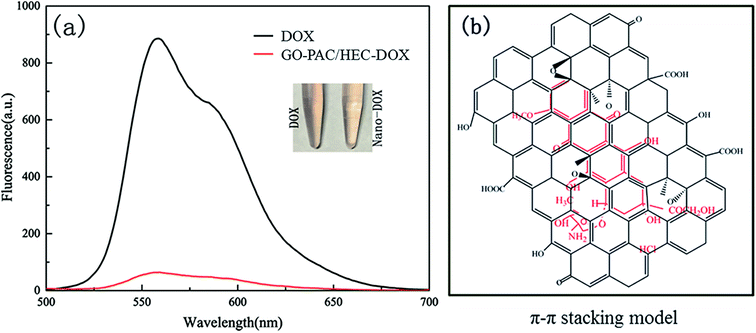 | ||
| Fig. 9 (a) Fluorescence spectra of DOX and GO–PAC/HEC–DOX at the 470 nm excitation wavelength. (b) Schematic of a π–π stacking model for DOX molecules on GO–PAC/HEC nanocarrier. | ||
3.5 In vitro drug release assay
In order to investigate the release characteristics of GO–PAC/HEC as drug delivery vehicles, the DOX-loaded nanocarriers were exposed to different pH value buffers. As shown in Fig. 10, under neutral condition (pH = 7.4, PBS), the moderate release rate of DOX from the nanocarriers lasted only 3 h and the cumulative release of DOX after 35 h was only 20% of the total loading, approximately. However, when exposed to an acidic microenvironment (pH = 5.0, acetate buffer), continuous fast release of DOX from the nanocarriers occurred up to 10 h, and over 80% of the total bound drug was released after 35 h. As previously reported by Chen et al.,45 there were abundant hydrogen bonds between DOX and GO sheets in addition to π–π stacking interactions. The different release patterns of DOX from GO–PAC/HEC were interpreted as due to the weaker hydrogen bonding and π–π stacking interaction between DOX and GO under acidic conditions. Under neutral condition, four kinds of hydrogen bonding can be formed between GO (–COOH, –OH) and DOX (–NH2, –OH). However under acidic conditions, –NH2 of DOX combined with H+ and formed –NH3+ instead of participating in hydrogen bonding with –OH of GO. The pH-responsiveness of GO–PAC/HEC is favorable for cancer therapy as solid tumors offer a more acidic microenvironment compared with normal tissues, which can intensify their susceptibility to chemotherapeutic drugs.46–48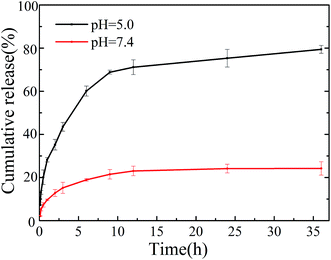 | ||
| Fig. 10 The cumulative release curve of DOX from GO–PAC/HEC–DOX at 37 °C in PBS, pH 7.4 and acetate buffer, pH 5.0, respectively. | ||
3.6 In vitro cytotoxicity
The cytotoxicity of GO and GO–PAC/HEC nanocarriers was evaluated by MTT assay against SKOV3 cells. SKOV3 cells were cultured in solutions containing different concentration of pure GO or GO–PAC/HEC with different equivalent GO concentrations for 48 h. As shown in Fig. 11, no significant cytotoxicity was observed even at the highest GO concentration (100 μg mL−1), and the same result had occurred in the GO–PAC/HEC with the highest concentration of 212.31 μg mL−1. Therefore GO–PAC/HEC is a suitably non-toxic vector for drug delivery.3.7 Intracellular distribution assay
Fluorescence microscopy was applied to evaluate the intracellular distribution of DOX-loaded nanoparticles. The intrinsic red fluorescence of DOX and the blue fluorescence of DAPI, were both employed to study the distribution of drug in both SKOV3 and SKOV3/DDP cells between 10 min and 4 h. As shown in Fig. 12, both free DOX and DOX-loaded nanoparticles were mainly located in the nucleus of SKOV3 and SKOV3/DDP cells due to the high affinity of the DOX molecule for DNA.49 Furthermore, the intensity of the red fluorescence of DOX became stronger with time, indicating increasing cellular uptake. No significant difference between the fluorescence intensity of free DOX and DOX-loaded nanocomposites in SKOV3 cells was observed (Fig. 12a). However, in SKOV3/DDP cells, the red fluorescence of free DOX was weaker than in the presence of DOX-loaded nanoparticles (Fig. 12b). Microscopy studies indicated that GO nanocarrier could effectively carry DOX molecules into cells and enhance the accumulation of DOX in SKOV3/DDP cells. This phenomenon should be confirmed by further cell experiments. | ||
| Fig. 12 Fluorescence microscopy images of (a) SKOV3 and (b) SKOV3/DDP cells in the presence of free DOX and DOX-loaded nanocomposites between 10 min and 4 h. | ||
3.8 Reversal of multidrug resistance
The ability of DOX-loaded nanoparticles to inhibit the proliferation of SKOV3 and SKOV3/DDP cells was investigated by MTT assay. The cells were cultured with DOX-loaded nanoparticles or free DOX at different DOX equivalent doses for 48 h. As shown in Fig. 13a1 and a2, the level of resistance of SKOV3/DDP cells to cis-DDP as expressed by the IC50 value was approximately four. Interestingly, compared to SKOV3 cells, the cytotoxicity of free DOX on SKOV3/DDP cells was substantially lower with the IC50 values being 0.55 ± 0.04 and 1.7 ± 0.06 μg mL−1, respectively, indicating that SKOV3/DDP cells were also resistant to DOX and the drug resistance index (RI = IC50 of drug-resistant cells/IC50 of parental cells) was about 3 (Fig. 13b2 and c2). This phenomenon indicated that SKOV3/DDP cells had multidrug resistance phenotypes. Furthermore, as shown in Fig. 13b1 and b2, the IC50 values of DOX-loaded nanoparticles and free DOX for SKOV3 cells was not significantly different (p > 0.1). However, DOX-loaded nanoparticles showed a relatively high cytotoxicity on SKOV3/DDP cells (IC50 = 1.1 ± 0.06 μg mL−1) and the reversal index was high significantly (p < 0.01). The results of the MTT assay further demonstrated that DOX-loaded nanoparticles could treat tumor effectively and reverse multidrug resistance. As represented in Scheme 2, the major reason for this distinctive difference in behavior was probably that DOX-loaded nanoparticles could attach to the cytomembrane and enter into the SKOV3/DDP cells by endocytosis and escape the identification and export activities of P-glycoprotein (P-gp) or multidrug resistance-associated protein (MRP).50,51 The previous research indicated that GO nanocomposites could enter into cells by endocytosis and mainly distributed to mitochondrion, endoplasm, lysosomes, and cell nucleus.52 In virtue of the low pH triggers, the drug was released from GO nanocomposites, which disrupted cellular energy metabolism and damaged DNA, thus leading to cell apoptosis or death. This phenomenon and mechanism have been also reported in the work of Wu et al. that the GO used as a carrier of Adriamycin could overcome drug-resistance in breast cancer cells.21 | ||
| Scheme 2 Schematic representation of the proposed mechanism of the mechanism of GO–PAC/HEC–DOX reversing DOX resistance of SKOV3/DDP cells. | ||
4. Conclusions
A novel mixed surfactant system of polyanionic cellulose and hydroxyethyl cellulose (PAC/HEC) was used to modify graphene oxide nanoparticles (GO–PAC/HEC) successfully based on the nonideal mixed micelle theory of surfactants. A multi-factorial orthogonal experimental design was used to establish a stable dispersion system, and the optimized drug-loaded nanoparticle system was investigated by zeta potential measurements and stability time test. The mixed surfactants proved to be highly biocompatible and not only improved the dispersibility and stability of GO under physiological conditions but also maintained high drug-loading capacity and allowed pH-responsive release. In this study, the representative tumor cell lines SKOV3 and SKOV3/DDP were used as model systems. The in vitro cytotoxicity of DOX-loaded nanoparticles produced similar antitumor efficacy compared to free DOX in SKOV3 cells but reversed multidrug resistance in SKOV3/DDP cells. The results presented in this study indicate that GO–PAC/HEC could have considerable potential as a drug delivery vehicle.Acknowledgements
This work was financially supported National Natural Science Foundation of China (81272466), Provincial Youth Science Fund of Heilongjiang (QC2011C037), Province International Cooperation Project (WB13C101).References
- I. V. Zibareva, Sci. Tech. Inf. Process., 2015, 42, 93–111 CrossRef.
- N. Barkalina, C. Charalambous, C. Jones and K. Coward, Nanomedicine: Nanotechnology, Biology and Medicine, 2014, 10, e921–e938 CrossRef PubMed.
- R. J. Koopmans and A. Aggeli, Curr. Opin. Microbiol., 2010, 13, 327–334 CrossRef PubMed.
- D. F. Emerich, Expert Opin. Biol. Ther., 2005, 5, 1–5 CrossRef CAS PubMed.
- V. Uskoković, J. Biomed. Nanotechnol., 2013, 9, 1441–1470 CrossRef.
- K. Riehemann, S. W. Schneider, T. A. Luger, B. Godin, M. Ferrari and H. Fuchs, Angew. Chem., Int. Ed., 2009, 48, 872–897 CrossRef CAS PubMed.
- P. Boisseau and B. Loubaton, C. R. Phys., 2011, 12, 620–636 CrossRef CAS.
- G. Brakmane, M. Winslet and A. M. Seifalian, Aliment. Pharmacol. Ther., 2012, 36, 213–221 CrossRef CAS PubMed.
- E. Esposito, M. Drechsler, R. Cortesi and C. Nastruzzi, Eur. J. Pharm. Biopharm., 2016, 102, 87–91 CrossRef CAS PubMed.
- B. Liu, H. Chen, X. Li, C. Zhao, Y. Liu, L. Zhu, H. Deng, J. Li, G. Li, F. Guo and X. Zhu, RSC Adv., 2014, 4, 48943–48951 RSC.
- X. Yang, M. Yang, B. Pang, M. Vara and Y. Xia, Chem. Rev., 2015, 115, 10410–10488 CrossRef CAS PubMed.
- E. V. P. Komarala, New J. Chem., 2016, 40, 423–433 RSC.
- M. I. Sajid, U. Jamshaid, T. Jamshaid, N. Zafar, H. Fessi and A. Elaissari, Annals of the Academy of Medicine, Singapore, 2016, vol. 13, pp. 340–344 Search PubMed.
- K. S. Novoselov, A. K. Geim, S. V. Morozov, D. Jiang, Y. Zhang, S. V. Dubonos, I. V. Grigorieva and A. A. Firsov, Science, 2004, 306, 666–669 CrossRef CAS PubMed.
- S. Stankovich, D. A. Dikin, R. D. Piner, K. A. Kohlhaas, A. Kleinhammes, Y. Jia, Y. Wu, S. B. T. Nguyen and R. S. Ruoff, Carbon, 2007, 45, 1558–1565 CrossRef CAS.
- D. Ma, J. Lin, Y. Chen, W. Xue and L. M. Zhang, Carbon, 2012, 50, 3001–3007 CrossRef CAS.
- T. Rattana, S. Chaiyakun, N. Witit-Anun, N. Nuntawong, P. Chindaudom, S. Oaew, C. Kedkeaw and P. Limsuwan, Procedia Eng., 2012, 32, 759–764 CrossRef CAS.
- F. Perrozzi, S. Prezioso and L. Ottaviano, J. Phys.: Condens. Matter, 2015, 27, 013002 CrossRef CAS PubMed.
- H. A. Becerril, J. Mao, Z. Liu, R. M. Stoltenberg, Z. Bao and Y. Chen, ACS Nano, 2008, 2, 463–470 CrossRef CAS PubMed.
- X. C. Qin, Z. Y. Guo, Z. M. Liu, W. Zhang, M. M. Wan and B. W. Yang, J. Photochem. Photobiol., B, 2013, 120, 156–162 CrossRef CAS PubMed.
- J. Wu, Y. S. Wang, X. Y. Yang, Y. Y. Liu, J. R. Yang, R. Yang and N. Zhang, Nanotechnology, 2012, 23, 355101 CrossRef PubMed.
- X. Yang, Y. Wang, X. Huang, Y. Ma, Y. Huang, R. Yang, H. Duan and Y. Chen, J. Mater. Chem., 2011, 21, 3448–3454 RSC.
- X. Sun, Z. Liu, K. Welsher, J. T. Robinson, A. Goodwin, S. Zaric and H. Dai, Nano Res., 2007, 1, 203–212 CrossRef PubMed.
- Y. Xu, Z. Liu, X. Zhang, W. Yan, J. Tian, H. Yi, Y. Ma, X. Zhang and Y. Chen, Adv. Mater., 2009, 21, 1275–1279 CrossRef CAS.
- H. Yang, C. Shan, F. Li, D. Han, Q. Zhang and L. Niu, Chem. Commun., 2009, 3880–3882 RSC.
- H. Hu, J. Yu, Y. Li, J. Zhao and H. Dong, J. Biomed. Mater. Res., Part A, 2012, 100, 141–148 CrossRef PubMed.
- Z. Liu, J. T. Robinson, X. Sun and H. Dai, J. Am. Chem. Soc., 2008, 130, 10876–10877 CrossRef CAS PubMed.
- P. Sungjin, M. Nihar, S. J. Won, N. Ashvin, J. An, R. D. Piner, W. Cai, D. R. Dreyer, B. Vikas and R. S. Ruoff, Adv. Mater., 2010, 22, 1736–1740 CrossRef PubMed.
- D. N. Rubingh, in Solution Chemistry of Surfactants, ed. K. L. Mittal, Springer, New York, Boston, MA, 1979, vol. 1, pp. 337–354, DOI:10.1007/978-1-4615-7880-2_15.
- N. Jadidi, B. Adib and F. B. Malihi, J. Surfactants Deterg., 2013, 16, 115–121 CrossRef CAS.
- S. Al-Faraji, R. S. Al-Maamari and M. Aoudia, J. Surfactants Deterg., 2015, 18, 113–121 CrossRef CAS.
- Y. Chen and G. Xu, Colloids Surf., A, 2013, 424, 26–32 CrossRef CAS.
- B. J. Palla and D. O. Shah, J. Colloid Interface Sci., 2000, 223, 102–111 CrossRef CAS PubMed.
- Y. Yamanaka and K. Esumi, Colloids Surf., A, 1997, 122, 121–133 CrossRef CAS.
- A. Menbari, A. A. Alemrajabi and Y. Ghayeb, Exp. Therm. Fluid Sci., 2015, 74, 122–129 CrossRef.
- B. Yin, J. Wang, H. Jia, J. He, X. Zhang and Z. Xu, J. Mater. Sci., 2016, 51, 5724–5737 CrossRef CAS.
- X. Liu, W. Kuang and B. Guo, Polymer, 2015, 56, 553–562 CrossRef CAS.
- C. Zeng, Z. Tang, B. Guo and L. Zhang, Phys. Chem. Chem. Phys., 2012, 14, 9838–9845 RSC.
- X. Zhang, J. Wang, H. Jia, B. Yin, L. Ding, Z. Xu and Q. Ji, RSC Adv., 2016, 6, 54668–54678 RSC.
- H. Maeda, Proc. Jpn. Acad., Ser. B, 2012, 88, 53–71 CrossRef CAS PubMed.
- J. Eastman, in Colloid Science, Blackwell Publishing Ltd., 2009, pp. 36–49, DOI:10.1002/9781444305395.ch3.
- J. Swarbrick and J. C. Boylan, Encyclopedia of pharmaceutical technology, Marcel Dekker, 2002 Search PubMed.
- X. Yang, Y. Lu, Y. Ma, Y. Li, F. Du and Y. Chen, Chem. Phys. Lett., 2006, 420, 416–420 CrossRef CAS.
- D. M. Guldi, M. Marcaccio, D. Paolucci, F. Paolucci, N. Tagmatarchis, D. Tasis, E. Vázquez and M. Prato, Angew. Chem., Int. Ed., 2003, 42, 4206–4209 CrossRef CAS PubMed.
- X. Yang, X. Zhang, Z. Liu, Y. Ma, Y. Huang and Y. Chen, J. Phys. Chem. C, 2008, 112, 17554–17558 CAS.
- P. Vaupel, J. Neuro-Oncol., 1994, 22, 261–267 CrossRef CAS PubMed.
- D. M. Prescott, H. C. Charles, J. M. Poulson, R. L. Page, D. E. Thrall, Z. Vujaskovic and M. W. Dewhirst, Clin. Cancer Res., 2000, 6, 2501–2505 CAS.
- K. Engin, D. B. Leeper, A. J. Thistlethwaite, L. Tupchong and J. D. Mcfarlane, Int. J. Radiat. Oncol., Biol., Phys., 1994, 29, 125–132 CrossRef CAS.
- K.-I. Kiyomiya, S. Matsuo and M. Kurebe, Cancer Res., 2001, 61, 2467–2471 CAS.
- H. Lage, Cell. Mol. Life Sci., 2008, 65, 3145–3167 CrossRef CAS PubMed.
- M. S. Singh and A. Lamprecht, Drug Dev. Ind. Pharm., 2016, 42, 325–331 CrossRef CAS PubMed.
- K. Wang, R. Jing, H. Song, J. Zhang, W. Yan, S. Guo and D. Cui, Nanoscale Res. Lett., 2010, 6, 1–8 Search PubMed.
| This journal is © The Royal Society of Chemistry 2016 |

